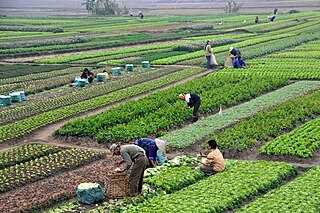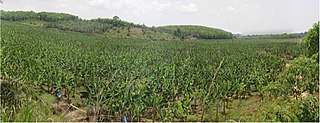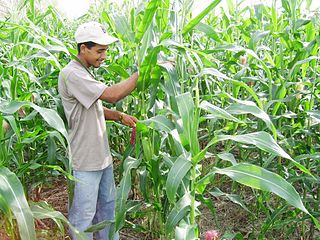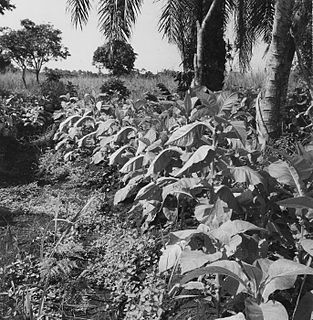This article needs to be updated.(August 2021) |
Nicaragua produces coffee, cotton, bananas, sugar and beef cattle.
This article needs to be updated.(August 2021) |
Nicaragua produces coffee, cotton, bananas, sugar and beef cattle.
In 2018, Nicaragua produced 7.2 million tons of sugarcane, being heavily dependent on this product. In addition to sugarcane, the country produced 395 thousand tons of maize, 365 thousand tons of rice, 300 thousand tons of palm oil, 252 thousand tons of banana, 209 thousand tons of cassava, 197 thousand tons of beans, 194 thousand tons of peanut, 141 thousand tons of coffee, 118 thousand tons of orange, in addition to smaller yields of other agricultural products such as pineapple, potato, sorghum, tomato etc. [1]
Nicaragua's relatively low population density and its wealth of land resources have both held the promise of solutions to poverty and been a major cause of it. [2] The importance of one or two crops has meant that the country's entire economy has undergone boom-or-bust cycles determined primarily by worldwide prices for agricultural exports. [2]
Coffee became the country's principal crop in the 1870s, a position it still held as of 1992 despite the growing importance of other crops. [2] Cotton gained importance in the late 1940s, and in 1992 was the second biggest export earner. [2] In the early 1900s, Nicaraguan governments were reluctant to give concessions to the large United States banana companies, and bananas have never been as important a crop for Nicaragua as they have been for Nicaragua's Central American neighbors; bananas are grown in the country, however, and were generally the third largest export earner in the post-World War II period. [2] Beef and animal by-products, the most important agricultural export for the three centuries before the coffee boom of the late 1800s, were still important commodities in 1992. [2]
From the end of World War II to the early 1960s, the growth and diversification of the agricultural sector drove the nation's economic expansion. [2] From the early 1960s until the increased fighting in 1977 caused by the Sandinista revolution, agriculture remained a robust and significant part of the economy, although its growth slowed somewhat in comparison with the previous postwar decades. [2] Statistics for the next fifteen years, however, show stagnation and then a drop in agricultural production. [2]
The agricultural sector declined precipitously in the 1980s. [2] Until the late 1970s, Nicaragua's agricultural export system generated 40 percent of the country's GDP, 60 percent of national employment, and 80 percent of foreign exchange earnings. [2] Throughout the 1980s, the Contras destroyed or disrupted coffee harvests as well as other key income-generating crops. [2] Private industry stopped investing in agriculture because of uncertain returns. [2] Land was taken out of production of export crops to expand plantings of basic grain. [2] Many coffee plants succumbed to disease. [2]
In 1989, the fifth successive year of decline, farm production declined by roughly 7 percent in comparison with the previous year. [2] Production of basic grains fell as a result of Hurricane Joan in 1988 and a drought in 1989. [2] By 1990 agricultural exports had declined to less than half the level of 1978. The only bright spot was the production of nontraditional export crops such as sesame, tobacco, and African palm oil. [2]
Historically, poor transportation limited production of sugarcane to roughly the same area in northwest Nicaragua where bananas were grown. [3] Demand for sugar remained comparatively low until the United States-imposed embargo on Cuban sugar began in 1960. [3] Demand then soared, and sugar production tripled over in the next two decades. [3] Like all other agricultural products, sugar production was severely hit by the United States trade embargo on Nicaraguan products from 1985 to 1990. [3] Production of raw sugarcane stood at 2,300 tons in 1989. [3]
Sugar production increased dramatically, and Nicaragua produced 7.2 million tons of sugarcane in 2018, being heavily dependent on this product. [1]
| | This section is empty. You can help by adding to it. (August 2021) |
| | This section is empty. You can help by adding to it. (August 2021) |
The first African palm oil plantations, which were established in the Caribbean lowlands, began production in 1990. [3]
Unlike in other Central American countries, political squabbles over who would control the plantations and shipment of the crop prevented bananas from becoming the major export earner in Nicaragua. [4] Bananas, a native fruit of tropical Asia, were introduced to Nicaragua early in the colonial period. [4] Initially, until a market for them appeared in the United States in the 1860s, bananas, like other fruit, were destined mostly for local consumption. [4]
Small plots of the Gros Michel variety of banana were planted for export, but political turmoil and difficulties in establishing secure transportation routes hampered export. [4] Because United States companies developed banana production in neighboring countries, Nicaragua's large potential for this crop remained underdeveloped. [4]
Politics and outbreaks of disease in the 20th century kept banana production low. [4] During their time in power, the Somoza family, who had discovered that coffee and cattle were more profitable than bananas, refused to give United States banana companies the free rein that they enjoyed throughout the rest of Central America. [4] In addition, an outbreak of Panama disease, a fungus that kills the plant's underground stem, wiped out most of the banana plantations in the early 20th century. [4]
New plants of the Valery and Giant Cavendish variety were planted, with constant use of fungicides was required to control black sigatoka disease. [4] Although Cavendish bananas yield three times the harvest of the older Gros Michel type, Cavendish bananas are more difficult to harvest and transport. [4] Cavendish bananas, for example, bruise easily and must be picked at an earlier stage and crated in the fields for transport. [4] Most banana production is in the Pacific lowlands, in a region extending north from Lago de Managua to the Golfo de Fonseca. [4] In 1989, banana production amounted to 132,000 tons. [4]
| | This section is empty. You can help by adding to it. (August 2021) |
Large-scale coffee growing began in Nicaragua in the 1850s, and by 1870 coffee was the principal export crop, a position it held for the next century. [5] Coffee is a demanding crop, however, because coffee trees require several years to produce a harvest, and the entire production process requires a greater commitment of capital, labor, and land than do many other crops. [5] Coffee also grows only in the rich volcanic soil found on mountainous terrain, making transportation of the crop to the market difficult. [5]
In 1992 more land was planted in coffee than in any other crop. The actual amount of land devoted to coffee varies somewhat from year to year, but averaged 2,100 km2 in the 1980s. [5] Production is centered in the northern part of the central highlands north and east of Estelí, and also in the hilly volcanic region around Jinotepe. [5]
Although production of coffee dropped somewhat in the late 1980s, the 1989 crop was still 42,000 tons. [5] Nicaragua's poor transportation system and ecological concerns over the amount of land devoted to growing crops on volcanic slopes in the Pacific region limit further expansion of coffee cultivation. [5] These limitations have led growers to explore planting other crops in undeveloped areas of the country. [5]
Cotton was Nicaragua's second biggest export earner as of the 1980s. [6] A latecomer to Nicaraguan agriculture, cotton became feasible as an export crop only in the 1950s, when pesticides were developed that permitted high yields in tropical climates. [6] Cotton soon became the crop of choice for large landowners along the central Pacific coast. [6]
As the amount of land under cultivation grew, erosion and pollution from the heavy use of pesticides became serious problems. [6] Lack of credit for planting, a drop in world cotton prices, and competition from Chile discouraged cotton production in the mid-1980s. [6] Production of cotton dropped significantly in the 1980s, and the 1989 crop of 22,000 tons was less than a third of that produced in 1985. [6]
The first cattle were brought to Nicaragua by the Spanish in the 16th century, and livestock raising was a mainstay of the early colony. [7] Drier areas on the western slopes of the central highlands were ideal for cattle raising, and by the mid-18th century, a wealthy elite, whose income was based on livestock raising, controlled León, Nicaragua's colonial capital. [7]
In the late 20th century, as was true in the late 16th century, cattle raising has been concentrated in the areas east of Lago de Managua. [7] Most beef animals are improved zebu strains. [7] Smaller herds of dairy cattle- -mostly Jersey, Guernsey, or Holstein breeds—are found near population centers. [7] A breed that is unique to Nicaragua is the La Reina.[ citation needed ]
In 1979 the new Sandinista administration quickly identified food as a national priority in order that the country's chronically malnourished rural population could be fed. [8] The government planned to increase production to attain self-sufficiency in grains by 1990. [8] Self-sufficiency in other dietary necessities was planned for the year 2000. [8] For a variety of reasons, however, including the private sector's retention of 60 percent of arable land, the Sandinista government continued to import food and grow cash crops. [8] In 1993 the goal of self-sufficiency in food production was still far from being achieved. [8]
To generate essential foreign exchange, the Ortega administration continued to support an upscale, high-tech agroexport sector, but returns on its investment diminished. [8] By 1990 only one-quarter of the pre-1979 area planted in cotton, one of the leading foreign exchange earners in the 1970s, was still under cultivation. [8] Despite an established priority for food production, food imports to Nicaragua grew enormously from the mid-1970s to the mid-1980s. [8]
In general, the Sandinistas made little progress in reducing economic dependence on traditional export crops. [8] To the contrary, faced with the need for food self-sufficiency versus the need for essential foreign exchange earnings, the Ortega administration, demonstrating scant economic expertise, continued to prop up the country's traditional agroindustrial export system. [8] They did so despite expensive foreign imports, diminished export markets, and a powerful opposing private sector. [8]
Revenues from traditional export crops continued their rapid decline throughout the 1980s. [8] Despite this drop, agriculture accounted for 29 percent of the GDP in 1989 and an estimated 24 percent in 1991. Agriculture employed about 45% of the work force in 1991. [8]
The economy of Honduras is based mostly on agriculture, which accounts for 14% of its gross domestic product (GDP) in 2013. The country's leading export is coffee (US$340 million), which accounted for 22% of the total Honduran export revenues. Bananas, formerly the country's second-largest export until being virtually wiped out by 1998's Hurricane Mitch, recovered in 2000 to 57% of pre-Mitch levels. Cultivated shrimp is another important export sector. Since the late 1970s, towns in the north began industrial production through maquiladoras, especially in San Pedro Sula and Puerto Cortés.

The economy of Nicaragua is focused primarily on the agricultural sector. Nicaragua itself is the least developed country in Central America, and the second poorest in the Americas by nominal GDP. In recent years, under the administrations of Daniel Ortega, the Nicaraguan economy has expanded somewhat, following the Great Recession, when the country's economy actually contracted by 1.5%, due to decreased export demand in the American and Central American markets, lower commodity prices for key agricultural exports, and low remittance growth. The economy saw 4.5% growth in 2010 thanks to a recovery in export demand and growth in its tourism industry. Nicaragua's economy continues to post growth, with preliminary indicators showing the Nicaraguan economy growing an additional 5% in 2011. Consumer Price inflation have also curtailed since 2008, when Nicaragua's inflation rate hovered at 19.82%. In 2009 and 2010, the country posted lower inflation rates, 3.68% and 5.45%, respectively. Remittances are a major source of income, equivalent to 15% of the country's GDP, which originate primarily from Costa Rica, the United States, and European Union member states. Approximately one million Nicaraguans contribute to the remittance sector of the economy.

In 2004, agriculture and forestry accounted for 21.8 percent of Vietnam's gross domestic product (GDP), and between 1994 and 2004, the sector grew at an annual rate of 4.1 percent. Agriculture's share of economic output has declined in recent years, falling as a share of GDP from 42% in 1989 to 26% in 1999, as production in other sectors of the economy has risen. However, agricultural employment was much higher than agriculture's share of GDP; in 2005, approximately 60 percent of the employed labor force was engaged in agriculture, forestry, and fishing. Agricultural products accounted for 30 percent of exports in 2005. The relaxation of the state monopoly on rice exports transformed the country into the world's second or third largest rice exporter. Other cash crops are coffee, cotton, peanuts, rubber, sugarcane, and tea.

Agriculture in Colombia refers to all agricultural activities, essential to food, feed, and fiber production, including all techniques for raising and processing livestock within the Republic of Colombia. Plant cultivation and livestock production have continuously abandoned subsistence agricultural practices in favour of technological farming resulting in cash crops which contribute to the economy of Colombia. The Colombian agricultural production has significant gaps in domestic and/or international human and animal sustenance needs.

Agriculture in the Philippines is an important part of the economy of the Philippines with crops like rice, coconut and sugar dominating the production of crops and exports. It employs 23% of the Filipino workforce as of 2021, according to the World Bank.

Agriculture in Ethiopia is the foundation of the country's economy, accounting for half of gross domestic product (GDP), 83.9% of exports, and 80% of total employment.
Agriculture continued to be the mainstay of the economy of Haiti in the late 1980s; it employed approximately 66 percent of the labor force and accounted for about 35 percent of GDP and for 24 percent of exports in 1987. The role of agriculture in the economy has declined severely since the 1950s, when the sector employed 80 percent of the labor force, represented 50 percent of GDP, and contributed 90 percent of exports. Many factors have contributed to this decline. Some of the major ones included the continuing fragmentation of landholdings, low levels of agricultural technology, migration out of rural areas, insecure land tenure, a lack of capital investment, high commodity taxes, the low productivity of undernourished animals, plant diseases, and inadequate infrastructure. Neither the government nor the private sector invested much in rural ventures; in FY 1989 only 5 percent of the national budget went to the Ministry of Agriculture, Natural Resources, and Rural Development. As Haiti entered the 1990s, however, the main challenge to agriculture was not economic, but ecological. Extreme deforestation, soil erosion, droughts, flooding, and the ravages of other natural disasters had all led to a critical environmental situation.

Angola is a potentially rich agricultural country, with fertile soils, a favourable climate, and about 57.4 million ha of agricultural land, including more than 5.0 million ha of arable land. Before independence from Portugal in 1975, Angola had a flourishing tradition of family-based farming and was self-sufficient in all major food crops except wheat. The country exported coffee and maize, as well as crops such as sisal, bananas, tobacco and cassava. By the 1990s Angola produced less than 1% the volume of coffee it had produced in the early 1970s, while production of cotton, tobacco and sugar cane had ceased almost entirely. Poor global market prices and lack of investment have severely limited the sector since independence.

Agriculture employs the majority of Madagascar's population. Mainly involving smallholders, agriculture has seen different levels of state organisation, shifting from state control to a liberalized sector.
Uganda's favorable soil conditions and climate have contributed to the country's agricultural success. Most areas of Uganda have usually received plenty of rain. In some years, small areas of the southeast and southwest have averaged more than 150 millimeters per month. In the north, there is often a short dry season in December and January. Temperatures vary only a few degrees above or below 20 °C but are moderated by differences in altitude.

Agriculture was the foundation of the economy in Ivory Coast and its main source of growth. In 1987 the agricultural sector contributed 35 percent of the country's GDP and 66 percent of its export revenues, provided employment for about two-thirds of the national work force, and generated substantial revenues despite the drop in coffee and cocoa prices. From 1965 to 1980, agricultural GDP grew by an average 4.6 percent per year. Growth of agricultural GDP from coffee, cocoa, and timber production, which totaled nearly 50 percent of Ivory Coast's export revenues, averaged 7 percent a year from 1965 to 1980.

Agriculture in Morocco employs about 40% of the nation's workforce. Thus, it is the largest employer in the country. In the rainy sections of the northwest, barley, wheat, and other cereals can be raised without irrigation. On the Atlantic coast, where there are extensive plains, olives, citrus fruits, and wine grapes are grown, largely with water supplied by artesian wells. Livestock are raised and forests yield cork, cabinet wood, and building materials. Part of the maritime population fishes for its livelihood. Agadir, Essaouira, El Jadida, and Larache are among the important fishing harbors. Both the agriculture and fishing industries are expected to be severely impacted by climate change.

Agriculture in Guyana is dominated by sugar and rice production. Although once the chief industry, is has been overshadowed by mining.

The role of agriculture in the Bolivian economy in the late 1980s expanded as the collapse of the tin industry forced the country to diversify its productive and export base. Agricultural production as a share of GDP was approximately 23 percent in 1987, compared with 30 percent in 1960 and a low of just under 17 percent in 1979. The recession of the 1980s, along with unfavorable weather conditions, particularly droughts and floods, hampered output. Agriculture employed about 46 percent of the country's labor force in 1987. Most production, with the exception of coca, focused on the domestic market and self-sufficiency in food. Agricultural exports accounted for only about 15 percent of total exports in the late 1980s, depending on weather conditions and commodity prices for agricultural goods, hydrocarbons, and minerals.

Throughout its history, agriculture in Paraguay has been the mainstay of the economy. This trend has continued today and in the late 1980s the agricultural sector generally accounted for 48 percent of the nation's employment, 23 percent of GDP, and 98 percent of export earnings. The sector comprised a strong food and cash crop base, a large livestock subsector including cattle ranching and beef production, and a vibrant timber industry.

Agriculture in Panama is an important sector of the Panamanian economy. Major agricultural products include bananas, cocoa beans, coffee, coconuts, timber, beef, chicken, shrimp, corn, potatoes, rice, soybeans, and sugar cane.

Agriculture in Spain is important to the national economy. The primary sector activities accounting for agriculture, husbandry, fishing and silviculture represented a 2.7% of the Spanish GDP in 2017, with an additional 2.5 % represented by the agrofood industry.

Agriculture in the Republic of the Congo is mostly at the subsistence level. Self-sufficiency in food production is yet to be achieved. Cassava (manioc) is the basic food crop everywhere in the country except in the southern region, where bananas and plantains are prevalent. Among the cash crops, the most important are sugarcane and tobacco, though palm kernels, cacao, and coffee are also cultivated to some extent. The main consumption crops are bananas, manioc, peanuts, plantains, sugarcane, and yams. Subsistence agriculture is the country's most significant employer, and it is one of the three most important economic sectors. With the government's efforts since 1987, agricultural production has increased due to "abolishing state marketing boards, freeing prices, launching new agricultural credit institutions and closing down most state farms". The Niari Valley in the south is a notable agricultural area.

Agriculture is the main part of Tanzania's economy. As of 2016, Tanzania had over 44 million hectares of arable land with only 33 percent of this amount in cultivation. Almost 70 percent of the poor population live in rural areas, and almost all of them are involved in the farming sector. Land is a vital asset in ensuring food security, and among the nine main food crops in Tanzania are maize, sorghum, millet, rice, wheat, beans, cassava, potatoes, and bananas. The agricultural industry makes a large contribution to the country's foreign exchange earnings, with more than US$1 billion in earnings from cash crop exports.